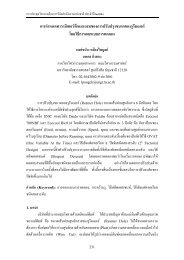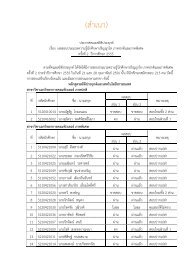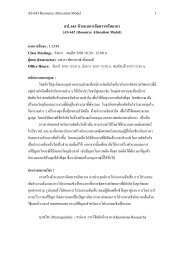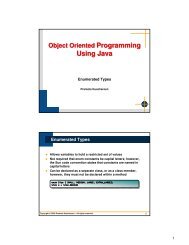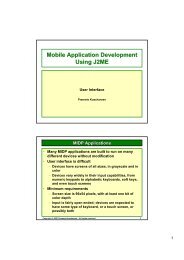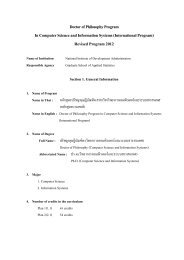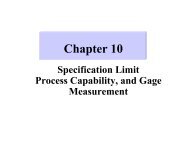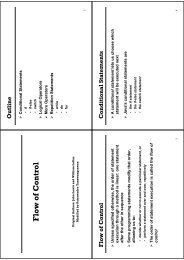ดาวน์โหลด All Proceeding - AS Nida
ดาวน์โหลด All Proceeding - AS Nida
ดาวน์โหลด All Proceeding - AS Nida
Create successful ePaper yourself
Turn your PDF publications into a flip-book with our unique Google optimized e-Paper software.
Table 5. ANOVA with all Main Effects and Interactions.<br />
Sources P-Value for the Etched Rate<br />
A 0.001<br />
B 0.029<br />
C 0.371<br />
A*B 0.791<br />
A*C 0.675<br />
B*C 0.169<br />
A*B*C 0.201<br />
Centre Point 0.162<br />
In order to determine the appropriate setting of the process<br />
variables, the main effects were plotted in Fig. 5. The appropriate levels<br />
of process variables A and B are set at 60 and 3.1, respectively. After an<br />
implementation of the new operating condition, the response of the<br />
etched rate is improved with the deviation of 1.365 and the three sigma<br />
level of 4.1 (Fig. 6)<br />
Mean<br />
Frequency<br />
16.8<br />
15.6<br />
14.4<br />
13.2<br />
12.0<br />
16.8<br />
15.6<br />
14.4<br />
13.2<br />
12.0<br />
40<br />
30<br />
20<br />
10<br />
-1<br />
1<br />
Main Effects Plot for Range<br />
Data Means<br />
A<br />
0<br />
C<br />
2<br />
1<br />
Fig. 5 Main Effect Plots of the Etched Rate Analysis.<br />
0<br />
43.5<br />
Histogram of Etched rate (Main effect)<br />
Normal<br />
45.0<br />
46.5 48.0 49.5<br />
Etched rate<br />
-1<br />
51.0<br />
B<br />
0<br />
52.5<br />
1<br />
Mean 46.84<br />
StDev 1.365<br />
N 216<br />
Fig. 6 Etched Rate Performance Measure at New Process Condition<br />
from the Factorial Design.<br />
55<br />
The method of multiple regression analysis at 95%<br />
confidence interval is then applied for statistically significant process<br />
variables to determine the most preferable fitted equation of associated<br />
process variables of A and B to the response of the etched rate (Table<br />
6). The relationship of the process variables and the response (RER) in<br />
terms of the path of steepest descent is<br />
Expected Response of RER = 63.1-0.171A-13.9B. (3)<br />
Table 6. Regression Model including its Significant Coefficients and<br />
ANOVA Table.<br />
Predictor Coef SE Coef T P-Value<br />
Constant 63.14 17.31 3.65 0.002<br />
A -0.1708 0.0382 -4.47 0.000<br />
B -13.875 5.738 -2.42 0.027<br />
Source DF SS MS F P-Value<br />
Regression 2 135.86 67.932 12.90 0.000<br />
Residual 17 89.557 5.268<br />
Total 19 225.42<br />
The preferable levels of process variables A and B from the<br />
path of steepest descent are 60 and 3.8, respectively (Table 5). When<br />
the new levels of process variables have been applied, the new etched<br />
rate is improved with the deviation of 1.124 and the three sigma level of<br />
3.4 (Fig. 7).<br />
Frequency<br />
30<br />
25<br />
20<br />
15<br />
10<br />
5<br />
0<br />
37<br />
Histogram of Etched rate (Multiple regression)<br />
Normal<br />
38<br />
39<br />
40 41<br />
Etched rate<br />
42<br />
43<br />
Mean 39.50<br />
StDev 1.124<br />
N 216<br />
Fig. 7 Etched Rate Performance Measure at New Process Condition<br />
from the Steepest Descent.




